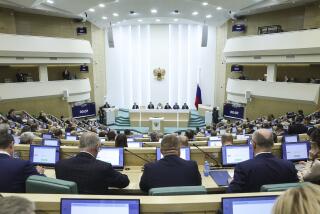THE MOSCOW SUMMIT : The Quest for Arms Control
- Share via
Here are some highlights of arms control history:
1963: U.S., Soviet Union and Britain limit nuclear tests in atmosphere, outer space and undersea.
1967: U.S., Soviets, British ban atomic weapons in space.
1968: U.S., Soviets, British sign Non-Proliferation Treaty, barring transfer of nuclear weapons to other states. (Treaty later endorsed by more than 130 other nations).
1969: U.S.-Soviet Strategic Arms Limitation Talks (SALT) begin.
1971: U.S., Soviets sign agreement to reduce risk of nuclear war by giving advance warning of nuclear missile tests, notifying of any accidental missile firing and other measures. With Britain, they ban undersea weapons
1973: President Richard M. Nixon and Soviet Premier Leonid I. Brezhnev agree to treaty limiting antiballistic missile systems and SALT I interim pact, freezing number of ballistic missile launchers at existing levels. NATO and Warsaw Pact begin Mutually Balanced Force Reductions talks in Vienna on troop reductions in Central Europe.
1974: U.S., Soviets agree to limit underground nuclear weapons tests. President Gerald R. Ford and Brezhnev agree to principles of SALT II treaty.
1975: Thirty-five governments including the U.S., Soviets sign Helsinki Declaration, a code of good neighbor relations in Europe that calls for advance notice of military maneuvers.
1979: President Jimmy Carter and Brezhnev sign SALT II treaty that limits some strategic offensive weapons.
1981: Superpowers open Geneva talks on limiting intermediate-range nuclear weapons, dubbed the INF negotiations.
1982: New strategic arms discussions begin in Geneva, dubbed START (Strategic Arms Reduction Talks) and conducted separately from INF negotiations.
1983: President Ronald Reagan announces Strategic Defense Initiative, an antimissile shield. Moscow suspends INF and START talks, citing U.S. deployment of cruise and Pershing II missiles in Western Europe.
1985: Soviet Foreign Minister Andrei A. Gromyko and Secretary of State George P. Shultz agree to resume INF and START talks. Reagan and Soviet leader Mikhail S. Gorbachev call for early progress on halving nuclear arsenals and interim INF accord.
1986: European Disarmament Conference in Stockholm produces detailed 35-nation agreement on advance notification and international inspection of military maneuvers. At summit in Reykjavik, Iceland, Reagan and Gorbachev agree in principle to slash strategic arms levels and cut INF missiles.
1987: U.S., Soviets agree to abolish all INF missiles over three years. Reagan and Gorbachev sign INF Treaty at Washington summit and both sides ratify it in 1988.
1989: NATO and Warsaw Pact open Conventional Forces in Europe talks in Vienna on cutting non-nuclear arms.
1990: U.S., Soviets agree to cut chemical weapon stocks to 500 tons each by the year 2005. U.S. later says it will eliminate them completely by that date. NATO and Warsaw Pact sign CFE treaty in Paris, but residual problems over Soviet compliance only settled in June, 1991. Thirty-five states sign new military confidence-building measures to be administered by a Conflict Prevention Center in Vienna.
July 17, 1991: U.S. and Soviet Union pronounce all outstanding START problems resolved and treaty expected to be signed at Moscow summit.
More to Read
Sign up for Essential California
The most important California stories and recommendations in your inbox every morning.
You may occasionally receive promotional content from the Los Angeles Times.










